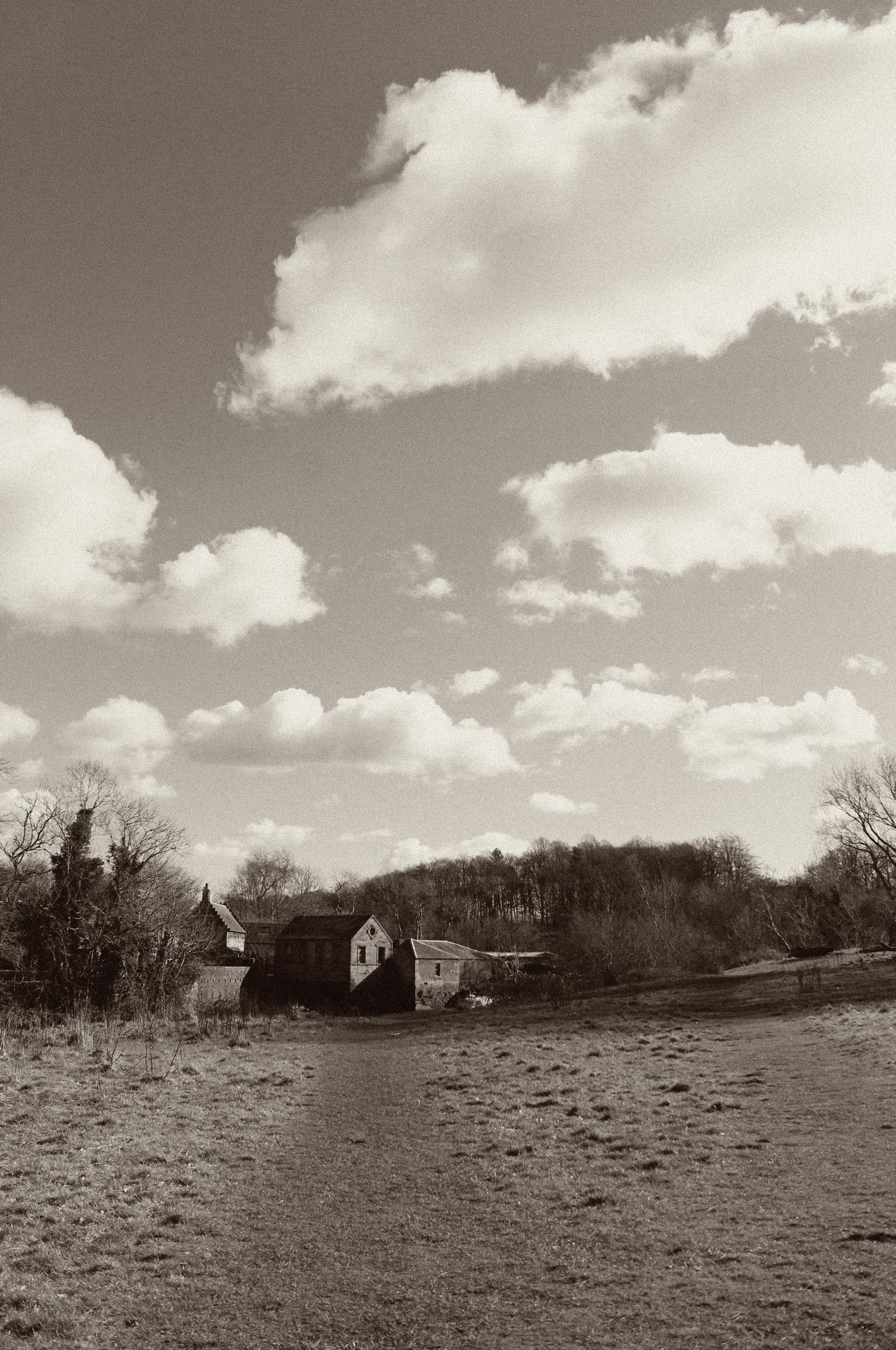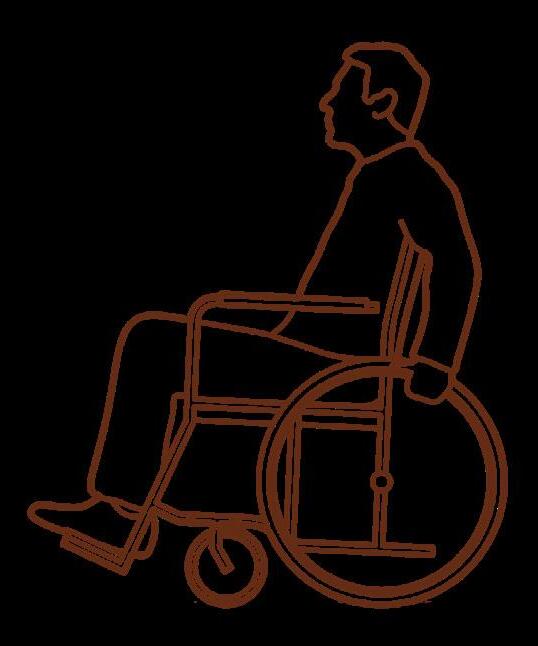caring home
A life-affirming home for the elderly
 Portfolio by Jenny Robinson
Portfolio by Jenny Robinson

 Portfolio by Jenny Robinson
Portfolio by Jenny Robinson
With a spatial approach centred around compassion, the ‘Caring Home’ enables elderly residents’ autonomy, connecting them with the life-affirming energy of nature and reassurance of community.
Challenging institutional stereotypes, the Home as imagined supports the continuation of life and its shared activities. Allowing inhabitants to enrich relationships with loved ones and expand wider social opportunities.
Embedding connections between the interior, exterior and surrounding landscape of Pollok Park, the intimate village-like Complex encourages multisensory experiences. Navigating dualities of light, sound, smell, and temperature, provides a therapeutic context that supports well-being.
Sensitive interventions to the historic buildings embed accessible spaces, offering independence for residents to live in the environment as they choose.


The increasing needs of an aging population intensifies the vitality of hopeful, health-giving care homes. Alleviating fears and institutional stereotypes, the environment must value and holistically support the identity, stories, memories and human needs of the elderly.
Site observation, October
Motivated by experiences of my Papa's care home, the project aims to provide a better lived experience for the elderly.
Symbolising societal attitudes towards aging, the existing care home interior institutionalises residents through a sense of confinement from the outside world. Removal from social, mental and sensory stimulants is detrimental to the sense of self and well-being of those confined indoors, and experiencing anxieties of moving into unfamiliar surroundings.
Personal and societal emotive perceptions of the care home;
- Institutionalisation results in the elderly feeling resistance to the care environment, fears of becoming cut off from loved ones and the homes they have built over a lifetime
- Residents lack of independence and autonomy of time/activity
- Associations with the care home as an end to life
Spatial problems of the contemporary care home;
- Anonymity of the interior devalues the identity of residents and is suggestive of temporality

- Clinical, oppressive atmosphere
- Synthetic lighting, colour and material palettes
Understanding the spatial problems and anxieties related to the existing care home aids in applying solutions to deinstitutionalise the interior.
“Soul, practicality and safety are in no way incompatible. Indeed, as disability restricts mobility, soul-nourishing surroundings are even more important”1
1. Author: Day, Christopher, Places of the Soul Architecture and Environmental Design as a Healing Art (New York: Routledge, Third Edition, 2014)
To provide the basis for a fulfilling life, the project should embody the spatial values that aid the design in meeting inhabitants needs,
Concept spatial values;
- Compassion
- Autonomy - Stability
- Protection/Exposure - Energy/Calm
- Multi-Sensory experiences
Nature;
- Water
- Flora
- Fauna - Air - Sky Time; - Memory
- Transitions
- Seasons - Weather
- Life/Death
Relationships;
- Old/Young
- Old/New
- Past/Present/Future
- Public/Private
- Indoor/Outdoor
Spatially provide compassion and care through an inhabitantcentric environment, supporting;
- Sensory stimulation
- Autonomy
- Human relationships and belonging to community
- Health and mobility issues of residents, and their choice to root into place
- Health-giving spaces and activities
- Connections between interior, exterior and surrounding nature
- Memory
- Supporting the roles of specialist care providers and staff
De-institutionalise the care home;
- Challenging institutional stereotypes linguistically and spatially, alleviate fears of the typology
- Enable residents to play an active role in their environment
Sensitively interact with the historic site;
- Interventions must enhance the structures and human experience within the Complex
- Adaptations must take a sustainable approach to materiality and potential renewable power sources
Therapeutic activities, social opportunities and a sensory design approach should aid the interior in enhancing well-being. Providing residents with stability regardless of health and mobility issues, the proposal must convey compassion for this sensitive transition within the lives of the elderly and their loved ones.
Situated in the slow pace of Pollok Country Park, along the banks of the White Cart Water, the Stables Courtyard Complex will become a Caring Home for the elderly.
Utilising the site and its context is a key facet of enhancing inhabitant well-being. Emphasising the therapeutic qualities of the historic buildings and natural surroundings aims to provide a reassuring and stimulating environment.
Location; Stables Courtyard Complex
Pollok Country Park
2060 Pollokshaws Road
Bellahouston
Glasgow
G43 1AT
Site observation, November
The relationship between interior and exterior is fundamental to the Caring Home, therefore, the atmosphere of site forms a central contribution towards the inhabitant experience.
Site atmosphere; Buildings;
- Low human proportions and domestic scale supports the intimacy of the Caring Home community.
- A threshold between feelings of village-like protection, and exposure to the ever-changing energy of seasonal elements.
Context;
- The invigorating sounds and smells of flowing water, wind through rustling trees, birdsong, people and families gathering permeate the Complex. This rich sensory experience enlivens the environment, and by extension its inhabitants.
Connections to amenities accessible by pathway, road and rail aids residents independence. Expanding their range of activities out-with the Caring Home complex contributes to a fuller life experience.
Key local amenities;
- Cafes/restaurants
- Shopping/retail
- Cinema
- Library
- Medical centres and hospitals
Key amenities within the Park;
- Pollok House
- Burrell Collection
- Allotments

The fluid nature of the settlement is described through various additions and subtractions across the 17th, 18th and 19th centuries. Structural alterations have historically allowed the Complex to evolve with the multi-functional demands of the former Maxwell estate.




In a state of neglect and deterioration, the A, B and unlisted buildings require sensitive design interventions that allow the site to support the contemporary needs of inhabitants and the wider community.





The central function of the Caring Home is to provide elderly residents with opportunities for a fulfilling life. Spatially enabling inhabitants to play a role in creating a supportive environment and community.

Compassion for the complex needs and desires of residents aims to positively contribute towards easing emotive connotations of the existing care environment. Holistically supporting individual abilities, disabilities and health conditions ensures this as a stable and enjoyable place to live.
Encouraging multi-generational relationships with loved ones and the wider community aims to promote inclusion.
“There is a useful and crucial difference between being in an environment and doing things in it.”2 , designs intend to value the autonomy of residents as active inhabitants of space.
Residents
Elderly residents live in the Caring Home to gain the support of staff and a social environment.
Diverse wants and needs require autonomy of private spaces to suit the individual, and tailored nursing and personal care.
Retaining and widening human connections and activities aids essential stimulation.
Loved Ones
Enabling relationships between residents and loved ones is vital for comfort and well-being. Encouraging short or long-term visits gives opportunities for people to enjoy time together, and form connections with other inhabitants.
If desired, loved ones may play a light-touch role in the care of their resident, retaining independence while allowing involvement.
Staff
Carers manage the personal care and requirements of residents, helping with daily activities as desired. Building relationships with residents and their loved ones aids feelings of trust and empathy.
Specialist nurses, physiotherapists and hydrotherapists further support individual needs.
Public
Existing multigenerational visitors to the park provide inhabitants with a range of potential interactions, widening social opportunities and integrating the Caring Home as part of the local community.
“Dancing leaf shade patterns, lapping wavelets, gurgling streams, endlessly reforming clouds combine calming tempo with the security of a reliably constant world, but one constantly stimulating our senses to life”3
3. Author: Day, Christopher, Places of the Soul Architecture and Environmental Design as a Healing Art (Oxford: Architectural Press, Second Edition, 2004)
The elderly spend around 80-90% of their time within the interior, heightening the necessity for accessible stimulation within everyday routines.
The Caring Home encourages multi-sensory experiences, drawing upon natural surroundings as a source of energy and healing. A holistic application of design responses sensitive to human sensory needs contributes towards de-institutionalising the contemporary care home.
Navigating dualities of light, sound, smell, temperature, indoor and outdoor, the Caring Home aims to accommodate the human need for fluctuations in sensory stimulation. Connections to the surrounding landscape aids the formation of a life-affirming interior.
Sensory design approach focuses;
- Protection/Exposure
- Energy/Calm
- Sound
- Light/Dark
- Tactility
- Smell
- Taste
- Temperature
- Sight
Nature;
- Water
- Flora and Fauna
- Air
- Sky
Time;
- Seasons
- Weather
Relationships with the historic structures;
- Old/New
- Past/Present/Future
Autonomous levels of sensory stimulation is vital in the creation of an enjoyable atmosphere. Sensitivity towards differing wants and needs of individuals requires the customisation of stimulants, avoiding environmental overload.


Interventions balance retaining structural and historic fabric, while making alterations that allow accessibility and a more inclusive range of inhabitants to use the Complex.
1 400 A3
Existing Roof Plans, with Proposed Demolition and Infill
1 : 800 A3
Existing slanted dormer windows are replaced with pitched dormers to create consistency across the courtyard building, see above.
The Caring Home values the autonomy of residents, enabling connections to community and well-being enhancing activities within a varied spatial context. Inclusive of health and mobilityneeds, all spaces are accessible.
Interaction with the public expands multi-age social opportunities, enhancing the village-like atmosphere of the historic buildings. Prospective residents and their loved ones may build familiarity with the Complex and its inhabitants, alleviating anxieties of the transition into the Caring Home.
The security of residents is ensured through high staff visibility across the Complex. Each building facilitates different aspects of the relationships and access between public and private space.
At the heart of the Complex, the Residence comprises living accommodation for residents and staying guests, housing a range of indoor and outdoor communal areas. Staff accommodation, office and utility areas aid in providing care.
The private Sanctuary supports calm and contemplation, a quiet space overlooking the river.
The Water Therapy Spa forms a regenerative retreat for inhabitants, healing through immersion in the pool, steam room and surrounding landscape. Hydrotherapy classes allow mixing with the public.
The Community Cafe serves as a neutral interaction space between inhabitants and the public, where people can eat indoors and outdoors, and participate in the sensory aspects of cooking.
The Community Garden enables inhabitants and the public to socialise, garden and exercise together in fresh air and south-facing sun.
The private car park may be used as a pickup/drop-off point for public transport, linking to local amenities. Spaces are fitted with EV charging points.
As recommended by the Care Inspectorate, the number of residents accommodated are between 6-10, depending on single or double occupancy of apartments.
This small domestic scale enables better quality care and relationships with staff, and reduces risk of outbreaks and stress due to over-stimulation.
Every space is designed to be accessible for wheelchair users.
Travelling from the car park and public transport drop off point, inhabitants enter the private Residence from the Southernmost wing. The threshold provides a transition between interior and exterior, before meeting residents and staff in the hallway. Then leading towards a large communal living, dining and kitchen area.
The courtyard extension provides space for a variety of activities, sliding glass doors may open or close to adjust exposure to the elements. Connecting private and public areas, people are invited to share a range of indoor and outdoor perspectives.
Staff areas are positioned to allow visibility, and minimise sound disruption.
- Arrows indicate up
A domestic-scale first floor communal living, dining and kitchen area provides additional space for relaxing, socialising or more private occasions. On the East corner, the small balcony gives views across the Community Garden.
All apartments are private and lockable.
Resident flats 1 and 2 are duplex, internally accessed by private lifts. Other apartments are entered through communal lifts and stairways, or via the extension.
Flats 5 and 8 are for the use of guests, providing opportunities for residents and loved ones to spend time together.

Apartments open out onto the extension, providing immediate and accessible opportunities to enjoy time with others, indoors and outdoors, while enveloped within the courtyard.
The single-storey form maintains the distinctive roof-lines of the Complex, and open views across the quadrangle. Designed to cast minimal shadows, allowing inhabitants to enjoy warm sunlight and stimulating fresh air.

Furnishings are arranged to support a range of group and individual activities, suiting those participating in group workshops and inhabitants who enjoy quiet reading while overlooking the courtyard.
Connections to communal kitchens on both levels encourages people to share meals in a variety of interior and exterior locations.
Portfolio by Jenny Robinson Section ACut First FloorVaried in layout and size, each apartment comprises a generous accessible bedroom, ensuite and living area. Ensuring residents have their own areas for relaxing and socialising.
Each resident apartment is designed to support the individuality of its inhabitant, and their varied needs and desires. The flats aim to provide a framework for evolving routines and activities, allowing flexibility for residents to play an active role in the creation of their home.
Specified schemes and arrangements are offered to residents, they may decide to bring their own furniture and customise finishes, such as paint colours and flooring. Original beams, fixed shelving, built-in wardrobes, fireplaces, kitchens, bathrooms will remain consistent within apartments, and create unity with communal areas across the Complex.
Each apartment gives a differing perspective across the courtyard and external surroundings. Looking out North towards the Walled Gardens, South to the river and West to Pollok House.
Domestic space is an extension of self, therefore residents have autonomy to use, display and store personal belongings.
Familiar objects provide comfort, easing the transition into a new environment, and creating ownership of space. These items are physical and emotive representations of loved ones, time and place. Communicating the identity of their collectors and aiding to evoke memories.
Flat 3 houses a large dualaspect bedroom. Daylight aids the inhabitants orientation in time. Birchwood shelves display precious items opposite the bed. A small seating corner provides a rest spot while dressing, and a place to enjoy the views and sounds of the river.
The bathroom features a spacious walk-in shower, with moveable stool for support.
An area overlooks the treelined paths towards Pollok House, and accommodates storage for a range of hobbies such as painting.
Residence; Floor Plan of Ground Floor Resident Accommodation, Flat 3
1 100 A3
Three of six apartments feature domestic-scale kitchens, arranged to allow the aromas of home cooking to fill the space if desired. Such familiar smells may bring comfort, particularly to those who are bed-bound, continuing feelings of the normality of home.
Flat 7 gives residents private space to enjoy cooking and baking, with an open dining/living area where they may share a meal with loved ones, or eat outdoors on the extension.
The dual-aspect bedroom gives views onto the Walled Gardens, deep walls provide window seats looking towards Pollok House and the river. The soft glow of Kartell Geen-a table lamps create a relaxing atmosphere.
The shower room sits under the apex of the former dovecot. Custom handrails in burnished brass give stability, and visual contrast against Ignorance is Bliss monochrome tiles.
Resident Accommodation; Specifications;
- Muuto, Rest 2 Seater Sofa in Kvadrat, Vidar 4 0146
- Resident, Pick-up Sticks Chair in Natural Oak and Kvadrat, Hallingdal 65 0227

- Resident, Pier Chairs in Solid Natural Oak
- Resident, Felix Swivel Chair (Black Base Casters) in Camira, Synergy Affix
- Custom kitchen in Scottish Wood, Scottish birchtimber
- Custom joinery/furniture in Scottish Wood, Scottish birch-timber
- Tylko, custom Burgundy sideboard
- Custom Grab-Rails in Burnished Brass finish
- Kartell, Geen-a Reading Lamp and Mini Geen-a Table Lamp in custom Burnished Brass finish
- Ignorance is Bliss, Ceramic Tile in MTPS_1

Materiality/Finishes;

- Lime plaster walls



- Original floorboards
Custom Grab-rails in Burnished Brass Ignorance is Bliss, Ceramic Tile in MTPS_1
590
Residence; Detail A showing Grab-rails 1 25 A3
Residence; Section B of Flats 4 and 7 and Ground Floor Arched Gateway
Zoning Maps highlighting Flats 5 and 8
Guest apartments play an integral role in creating opportunities for residents and loved ones to enjoy time together.
Supporting human relationships is fundamental to the Caring Home. Vital, particularly at times of ill-health, multi-generational connections to loved ones aids feelings of comfort and sense of self.
“For many elderly, contact with grandchildren keeps them alive.”4
Valuing the continuation of family life, short and long-term visits are encouraged. Enabling those who stay to strengthen their relationship with their partner, parent, grandparent or friend. Normalising the experience of visiting a loved ones home.
The guest apartments may additionally function as a place to isolate staff or members of a couple, should anyone fall ill.
Flat 5 accommodates 1-4 people. The slightly larger of the two guest apartments, with an additional room overlooking the Walled Gardens.
The fixed bench seating within the garden room functions as a single bed, a cosy corner for a grandchild.
Enveloped in the curves of the former staircase, the shower provides a place to unwind.
The bedroom is fitted with built-in wardrobes and shelving, providing storage for short and long-term stays. Planted window boxes obscure views, aiding privacy.
Tylko, custom Burgundy sideboard
Muuto, Rest 2 Seater Sofa in Kvadrat, Vidar 4 0146

Residence, Guest Accommodation; Specifications;
- Christopher Farr, custom Basket Weave Crimson Rug
- Muuto, Rest 2 Seater Sofa in Kvadrat, Vidar 4 0146
- Custom built-in wardrobes, shelving and sideboard in Scottish Wood, Scottish birch-timber
- Tylko, custom Burgundy sideboard

- Kartell, Mini Geen-a Table Lamp in custom Burnished Brass finish
- Ignorance is Bliss, Ceramic Tile in MTPS_1
Materiality/Finishes; - Lime plaster walls
- Original floorboards

The extension bridges private and communal space, linking residents together and inviting interaction across the courtyard.
Its offset form is orientated towards the South, angling inhabitants towards the sun and shade across vertical perspectives.


“In the morning, the warm rays emerge from one side and slowly make their way across the space throughout the day - bringing life and energy indoors - before fading into dusk”5
Allowing inhabitants connection to changing weather, light and seasons all year. Enabling opportunities to enjoy the warmth of the sun, breathe fresh air and feel the breeze.
Glass sliding doors allow the ground floor to open and close, adjusting shelter and exposure to the outdoors.
A cloistered pathway is formed by exposed timber columns and beams, drawing people around the central planting. The semi-enclosed structure graduates the transition between interior and exterior, framing views up and opposite. Its geometric pattering relates to original angular stepped gabling, defining a new dynamic between delicate timber framework and deep sandstone walls.
The first floor provides an elevated perspective over the goings-on across and below.
Inhabitants move through the Southern communal wing, spectating or participating in a range of shared activities. Sequential doors allow areas to be sectioned off, enabling privacy and reducing over-stimulation.
The kitchen dining area forms a social hub that encourages participation in cooking between staff and residents. Involving everyone in the stimulating sounds and smells of food enhances the experience of eating together. Connections to domestic activities aids feelings of normality and independence.
The harness-like leather Flos Belt light creates a statement above the dining table, referencing the rooms historic function as a former stables.

The framework for the extension is formed of 203x203mm Glue Laminated Birch beams and columns. Specified for its wide span and high-strength, this material aids the creation of slender forms, retaining maximum views across the courtyard and reducing the volume of wood required.

Lightweight aluminium sliding glass doors line the ground floor. Window frames align with the centre line of the opposite column, allowing them to disappear depending upon perspective.

A birch-timber balustrade unifies with the structural frame and other custom joinery across the Complex. Stacked WasteBasedBricks in Orange Punched pave the ground and upper floors, and detail the vertical edge of the floor.




The care provided by staff is fundamental to the experiences of residents. Spatially enhancing work-flows aims to ease stress and create a comfortable and functional environment.
Providing staff space to refresh and recuperate conveys appreciation towards the efforts and compassion of carers. The separation of overnight accommodation and staff room helps form mind-space while on breaks.
Positioned adjacent to the entrance and communal areas, staff have a visible presence, aiding monitoring and security.

To minimise contamination, all utility areas have general and hand-wash sinks. Thickened walls and placement away from resident apartments insulates from noise.
Considered staff circulation routes minimises contamination, aiding the following of safe procedures and easing work-flows.
Internal and external access allows for deliveries and disposal of waste.
The threshold to the Residence courtyard reveals the historic structure, taken back to tactile hewn sandstone and wooden roof beams to form a semi-enclosed internal garden. Honesty in exposing the original construction states the symbolic acceptance of patina and a less fearful approach to aging.
Creating a graduation between indoor and outdoor, the ruin aids the transition between the private residence hallway and public space, bringing inhabitants into the rest of the Complex.

Referencing the buildings existing state of deconstruction, this intervention was inspired by the open fabric of roof beams that form geometric patterns depending upon perspective.


"Aging beautifully with use, natural materials develop a patina that tells the story of days, years and decades of exposure to their environmentmirroring all they've experienced. We can take comfort from places and things with history, that tell us how old they are and what they know."6Section F A Muuto In Situ Modular 4 seater sofa provides versatile seating positions, both facing towards the coat storage, and lounging while facing visitors approaching the threshold. 6. Norm Architects, Soft Minimal: A Sensory Approach to Architecture and Design (Berlin: Gestalten, 2022)

The former Chapel will provide a quiet Sanctuary within the Complex, where inhabitants can shelter and relax.
A place to sit and read a book, while watching the White Cart Water as it flows past. Providing space for private conversation over a cup of tea, perhaps between loved ones and carers. Here, those experiencing loss or anxiety can come to feel a sense of calm and reassurance.
The Sanctuary reading area and viewpoint are privately accessed by Caring Home inhabitants.
An externally accessible DDA toilet is available for the public, ensuring easy access for those out on walks, while retaining the privacy of the Sanctuary.
The geometric forms of the brass threshold and softly up-lit roof beams reference the rhythm of the buildings stepped gables.
Aligned with the arrowslit window, a narrow glazed channel is cut spanning the roof ridge, connecting those who look up to the sky above.
While access remains private, the Sanctuary may be used by the loved ones of former residents, to maintain relationships with those who knew or looked after their resident. Enabling the reassuring continuation of community support, and providing a familiar place to remember.




Sanctuary; Specifications;
- Custom threshold in Burnished Brass

- Custom shelving in Scottish Wood, Scottish birch-timber
- Muuto, Rest Sofa 2 Seater and custom Armchairs in Kvadrat, Vidar 4 0146
- Kartell, Geen-a Reading Lamp in custom
Burnished Brass finish
- Christopher Farr, Plaid Rug in Blue Wool, visually connecting to the tones of clear skies
- Curtain in Loaf, Egg Box
Clever Vintage Linen
Materiality/Finishes; - Lime plaster walls embrace the natural imperfections of the sandstone structure
- Aren Bianco Limestone tiles line the floor, with a fine lime mortar and grid layout
Providing contrast to the scale of existing openings within the building, the new glazed insertion connects inhabitants to the White Cart, as it flows directly below.
The viewpoint opens out towards the South West, infusing the space with warm sun. Its elevated orientation towards the stillness of the opposite river bank allows inhabitants to immerse in a sense of seclusion and enclosure.
Richly textured textiles and deep seating provide a soft and tactile experience. The warm atmospheric glow of brass against sculptural forms and geometric patterning creates an engaging, but not over-powering, environment.

The Water Therapy Spa provides a regenerative retreat for inhabitants, where the healing properties of water are heightened through immersion in the surrounding landscape.
Health-giving activities encourage well-being and the building of strength and confidence. At the meeting point of the White Cart, its weir and lade, spatial connections to the fluctuations and energy of the waterways enhance the atmospheric experiences of swimming and relaxing.
Water has determined the importance of this site for centuries, at the heart of Pollok’s origins, the Complex was once the grounds of Laighe Castle,
“The castle was built upon a rock that was washed by the White Cart. The pool that formed here is believed to have led to the name Pollok, as the word ‘poll’ means pool in Gaelic.”
The design sensitively emphasises the meaningful relationships between the waterways and interior.
Generously spaced shower and changing rooms ensure comfort for all, accommodating families and those with mobility issues, or who may need the assistance of carers.
Tiled seating opposite the pool serves as a place to relax. Providing a spot for spectators to soak in the atmosphere.
A cool shower and drinks area offers refreshing contrast in temperature after using the steam room.
A hydroelectric turbine harnesses the power of the weir, acting as a renewable energy source for the Complex.

1 150 A3
Inhabitants follow a journey that emulates the path of the lade, taking them from reception to the changing area.


A narrow passageway then forms a separating threshold. Softly up-lit undulating roof beams draw people towards glimpses of the water, before opening out onto the pool and steam room.
Emphasising the escapism of the Spa, the floor is sunken to 775mm below ground-level. The lowering of eyelevel dramatises the height of existing windows, inviting people to look upwards towards the changing moods and weathers of the sky.
The slow transition of the pools ramp connects people to the adjacent descent of the river. Swimmers move towards the deepest point, where the White Cart and lade converge underneath. A horizontal glazed panel spans an existing opening, visually connecting the pool outwards towards the bends of the river.
Graduated depths relate to the fluctuating river-levels. The relationship between this rising and lowering is heightened in the varied sounds of the weirs cascade, enriching the experience of people swimming and floating in the interior.

“In shadowy spaces, vision finally takes a back seat. Touch, hearing and smell gain heightened sensitivity and our subconscious, unburdened by excessive visual stimuli, can roam. ... Physically, a dimly lit corner envelops our body and secludes us from the world, encouraging a safe and private mindset.”7
Providing contrast to the rest of the Complex, the Spa heightens sensory stimulation through a focus upon the experience of darkness.
A limited materiality palette emphasises the hues of seasonal surroundings. Ignorance is Bliss amber toned Ceramic Tiles in FE20SM_1 reference the autumnal browns of the White Cart Water.

Inspired by the buildings history as a former Sawmill, richly textured black charred timber lines the walls. Inhaling the warm smell of wood in the steam room induces feelings of calm. Increased circulation aids mental health through reducing tension and stress.

Soaking in the heat of the pool contributes towards healing, relaxing muscles and relieving joint pain. Weekly hydrotherapy classes encourage routine exercise, and the building of strength and confidence. In such classes, inhabitants may mix with the public to partake in lowimpact activities, beneficial for the elderly and those with dementia.
Ignorance is Bliss, Ceramic Tile in FE20SM_1
Shou-SugiBan, Yūkari Umi Charred Timber
Water Therapy Spa; Specifications;
- Ignorance is Bliss, Ceramic Tile in FE20SM_1, glaze contains 20% iron waste - Resident, Felix Swivel Chair (Black Base Casters) in Camira, Synergy Affix, used by staff in the reception
Materiality/Finishes;
- Abodo Wood, Vulcan Walnut Fine Sawn
- Shou-Sugi-Ban, Yūkari Umi Charred Timber

The Community Cafe serves as a neutral interaction space between inhabitants and the public, where people can eat together and participate in the sensory aspects of cooking.
Focused on widening inhabitants social opportunities through activity, people are invited to take time to connect over a sit-in lunch. Welcoming people to buy from the Cafe or bring their own food.
Contributing to a multi-stimulatory eating experience, the smells and sounds of cooking heightens the taste of local produce grown in the Community Garden and Walled Gardens adjacent to the Complex.
Encouraging multi-age involvement in cooking, the central kitchen accommodates public/private events and workshops. Blending front and back of house aims to create an open atmosphere, enabling the sharing of skills and knowledge around cooking and ingredients.
Reconfigurable suspended lighting and seating arrangements serve the activities and seasonal needs of the Cafe. Cable lengths on pendant lamps may be hooked to alternate positions to match table layouts.
Eating outdoors is encouraged in warmer weather, allowing people to enjoy sociable meals with views across the Community Gardens.
The interior provides shelter in colder weather, enabling social connections to be retained year round.

Innovative materiality and FFE specifications aid the creation of a stimulating and sustainable interior.
Dining chairs formed of Solidwool Welsh Mountain biocomposite strike the balance between practicality and tactility. Utilising locally sourced waste wool to create a durable and characterful finish.
Nunoko Pendant lamps are grown using organic mycelium biocomposite, when composted, this biodegradable material adds nutrients to the soil, forming part of the food cycle.
Community Cafe; Specifications;
- Resident, custom Pier Dining Chair in Solidwool, Welsh Mountain biocomposite
- Resident, Carousel custom Armchairs in Kvadrat, Vidar 4 0146

- Nunoko, Kepure and Kepurele Pendant Lamps in mycelium biocomposite


- Ignorance is Bliss, Ceramic Tile in MTPS_1, glaze contains 1.5% mix metal waste
- Rugvista, Seaby Rugs in Rust Red
- Custom kitchen in Scottish Wood, Scottish birchtimber
- Custom dining tables and coffee table in Umber Stained Oak
Materiality/Finishes;

- Lime plaster walls
- Aren Bianco Limestone tiles


The existing portion of flat roof is replaced with pitched beams, visually integrating their sculptural forms with the remaining parts of the cafe’s ceiling.
Solidwool, Welsh Mountain Biocomposite
Nunoko, Kepure Pendant Lamp
Resident, Carousel custom Armchairs in Kvadrat, Vidar 4 0146
Formed of 30mm thick Scottish birch-timber, the open grid structure of the central kitchen units is highlighted by box joint detailing and 3mm shadow gaps around cabinet doors.

Incorporating a 450mm high window seat gives inhabitants a rest point.
Stacked Ignorance is Bliss tiles in MTPS_1 add patterning and texture with its monochromatic glaze, speckled with 1.5% metal waste.
is

Section Detail B describes the staggered heights of the kitchen island, designed for people to gather and cook together. Closed units with built-in cabinets are used while standing, opposite, an open countertop at 790mm high is tailored to the needs of wheelchair users.


The Community Garden provides an outdoor gathering point, where inhabitants can socialise, garden and exercise, while enjoying the south-facing sun.
Connecting elderly residents to the outside world in an immediate and accessible way, bringing them together with a range of multi-generational people within renewing fresh air and natural surroundings.
Enveloped within a variety of green-spaces, the Community Garden enables safe access to the outdoors within the Complex, as overseen by staff. Answering the need for inclusive access to gardening activities, this space invites inhabitant and public involvement regardless of mobility issues.
Utilising a previously underused area, the proposed pathways reference the routes of the former Orchard. Rediscovering a range of walking routes and perspectives, and reintegrating connections to the Community Cafe and Walled Gardens.
Fixed seating lines the boundary wall, creating rest spots and meeting places for conversation and people-watching.
The Community Garden is accessible to all inhabitants and the public.
The private car park is available for Caring Home inhabitants and may be used as a pick-up/drop-off point for public transport.


Designed to be accessible for all, the custom raised bed sits 670mm above the ground, minimising the need to crouch or bend. Enabling those in wheelchairs, and people who find sitting or standing more comfortable to be involved in activities.
Arranged to encourage the social aspect of gardening, people can face towards each other, creating opportunities for conversation and workshops. Residents may lead or take part in learning about horticulture.
Community Garden; Specifications; Stone Cycling, WasteBasedBricks (formed of at least 60% construction waste) in Almond Punched, with a fine lime mortar and stacked grid layout are applied to; - Custom raised bed

- Custom fixed seating - Paving of paths and outdoor dining area

